Steel and Aluminum are the two most popular materials when it comes to making structures. Yet, steel seems to win more. One of the ways that it beats Aluminum is in fatigue because aluminum does not have an endurance limit.
Aluminum does not have an endurance limit because of the material’s microstructure. Many metals have a face centered cubic structure while steel has a body centered cubic structure. The body centered cubic crystalline structure leads to harder and less ductile materials.
What is Fatigue
Fatigue is the cyclical loading and unloading of a material. The load may be fully reversing from full equal tension and compression like a cantilevered load on a rotating shaft. It could also be loaded from no load to full tension or any combination in between.
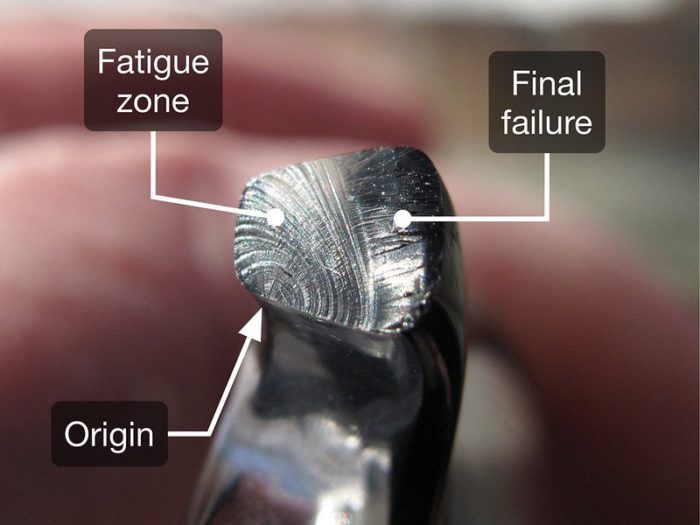
Fatigue is a very complicated issue; far to broad to discuss in detail here. Let’s look at the example of a screw that is cyclically loaded from no load to 40 kips. When designing this system, we definitely want infinite life in our fastener.
Mean and Alternating Stresses
Finding the average (mean) stress and the alternating stress on the fastener can be calculated from the minimum and maximum stresses on the fastener. In our example above, we will use a 3/4″ Grade 8 bolt. This bolt has 150 ksi tensile strength and a cross sectional area of 0.334 in2.
Looking at the calculations below, we see that our mean and alternating stress are equal at roughly 60 ksi.
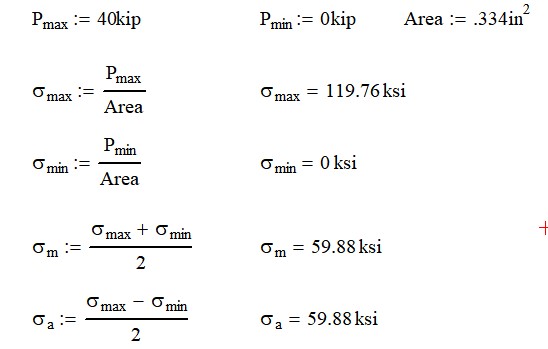
Now, we need to a way to evaluate if this is good enough. There are several tools we can use; the Goodman, Soderberg and ASME Elliptical. I choose to use the ASME Elliptical Criterion because it seems to fit the empirical data better.
We also need to know the Ultimate or Tensile Strength and the Endurance Limit. The ultimate strength of a bolt is readily known, but the endurance limit is a little more tricky and many materials don’t have one.
The endurance limit is the maximum alternating stress that a material can withstand forever when there is not mean stress. For steel, this value can be as high as 1/2 of the ultimate stress to lower than 40%. If you don’t know what the endurance strength of your material is, I would use a factor of 1/3.
From here, we can use the ASME Elliptic Criterion to evaluate if the fastener will survive. Values below 1.00 indicate the fastener is properly designed.
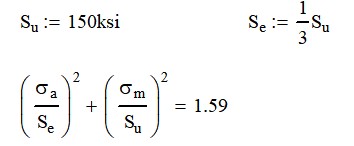
What is the Endurance Limit
The endurance limit of a material is the stress at which the material can be loaded repeatedly without failure. The chart below is a fitted curve to the data. Curve A shows a material that has and endurance limit, Se. You can see that it is horizontal line after about 2 or 3 million cycles (its a logarithmic scale).

However, Curve B does not have an endurance limit; the slope is constantly decreasing. This means that there is no such thing as “infinite life” with materials like aluminum.
What we need to do in this case is to figure out how many cycles our structure really needs to withstand. This is not to difficult to estimate in most cases. Many pieces of equipment that I have designed never saw more than 200,000 cycles.
In this case, you would take your cycles and multiply them by a design factor (I use 2). I would see where Curve B intersects the expected life with the design factor. This would be your “endurance limit” that would be used in equation above.
Why Does Steel Have an Endurance Limit
The real question isn’t why aluminum doesn’t have an endurance limit. It is why does steel have one? The answer lies in the crystalline structure of the materials.

A. Face Centered Cubic
Materials like lead, copper, nickel and aluminum are face centered cubic lattice structures. This structure type is the most ductile because there are well defined slip planes in the material. Slip planes are where the atoms in the material can slip past each other when shear load is applied. For more information on this subject, please read this article.
Creep
With the face centered cubic, these materials are prone to creep which is continual deformation of the material at low temperatures and under load.
Aluminum wiring is popular because it conducts electricity better than copper. However, it does change shape over time when under load. This leads to the wire conforming to the shape of a typical screw terminal. This will lead to a loose wire, sparking and possibly electrical fires. For this reason, special terminals must be used with aluminum wiring.
While both copper and aluminum are face centered cubics, the rate of aluminum is 25 times more than that of copper.
B. Body Centered Cubic
A body centered cubic has 8 direct neighboring atoms. It looses a little ductility, but in return it gains strength. It is harder for slip to occur in a body centered cubic. Examples are chromium, iron (steel), molybdenum, tungsten and vanadium. It is interesting that many of the metals used to give steel unique properties are also BCC.
C. Hexagonal Close Packed
The hexagonal lattice structure is surrounded by 12 direct neighboring atoms and offers the most strength with the least amount of ductility. Examples of this are cobalt, titanium, magnesium and zinc.
Why Does The Structure Matter
The structure matters because the face centered cubic will be too weak and ductile to carry any real load. Aluminum, while strong, has a maximum yield strength of roughly 40 ksi (275 MPa) after thermal processing. Steel, a body centered cubic, can have strengths up to 300 ksi (2068 MPa).
There is also a noticeable reduction in ductility for steel when compared to Aluminum. For steel, ductility is generally around 15% to 25%. However, Aluminum that has a minimal amount of thermal processing can have ductility approaching 40%.
The increased ductility caused by well defined slip planes prone to material creep is the main source of why Aluminum does not have an endurance limit.
When Should I Use Aluminum in Fatigue
Now to the practical application. Aluminum has many great qualities that steel just can’t match up with; namely its light weight and corrosion resistance. Aluminum’s main drawbacks are its lack of fatigue strength, poor weld strength and cost.
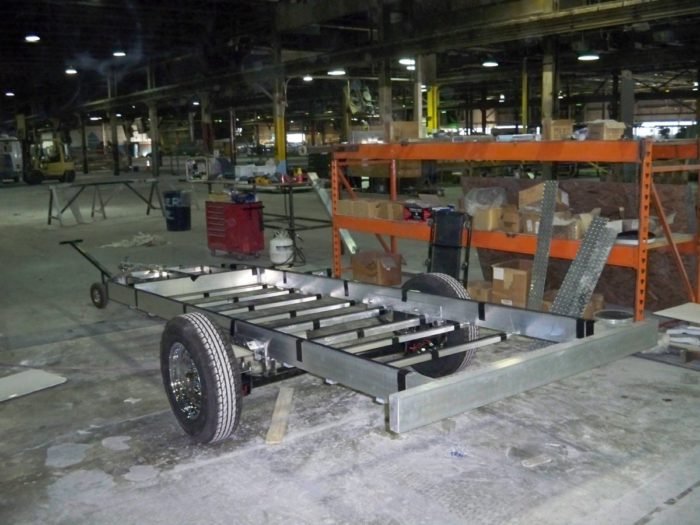
Note the lack of welds in this trailer design
I would recommend using unwelded Aluminum for low cycle fatigue. These are applications where the number of cycles the material will see is predictable.
Aluminum is used on airplanes because there are very predictable load cycles. A plane probably only has high loads on it at takeoff and landing. If it does this 7 times a day for 30 years, this is only 153,000 cycles.
You would not want to use Aluminum in a trailer design because it will see many millions of cycles over a few years. Every bump puts new loads of unknown magnitude into the structure. High cycle fatigue quickly becomes an issue.
Does Welding Aluminum Weaken the Metal?
Have you ever noticed that airplanes are riveted together and not welded? There’s a good reason for that. Welding on aluminum will weaken the design. The heat from the welding process will remove all thermal processing from the parent material leaving it in a T-0 condition. For 6061-T6 that is a reduction from 40 ksi (275MPa) to 7 ksi (48 MPa). Ouch!
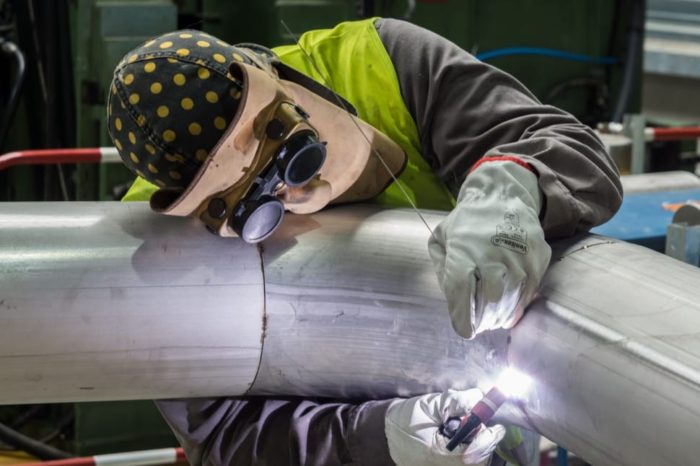
This is the reason why aircraft manufacturers avoid the weld process altogether and choose a mechanical process.
Side note – Another reason is that the rivets will distribute stress differently than a welded joint. When ships started converting from riveted design to welded design, they used the same proven designs. As a result, cracks started developing because the stresses were transferred from one piece to another in new ways. Some ships sank as a result.
Thermal Processing
When your weldment is complete, you may have tubes and bars that are a certain tempers like T-6 (full strength) and T-4 (half strength), but your welds are at T-0. It is possible to process the weldment to regain the T-6 temper by having the weldment heat treated. Unfortunately, this is another costly process and depending on how large your weldment is, it may be impossible. At this point, it may be better off to switch to steel.
I wonder how much a heat treat oven the size of a 747 costs….
Summary
The face centered cubic crystalline structure of Aluminum offers great ductility in the material at the expense of strength. This is the underlying cause of why Aluminum does not have an endurance limit and why it is not a good choice for high cycle fatigue loadings.
Welding Aluminum removes the temper of the parent material due to the heat from the weld. It can be heat treated to regain strength, but more often than not it is not cost effective to due so.

